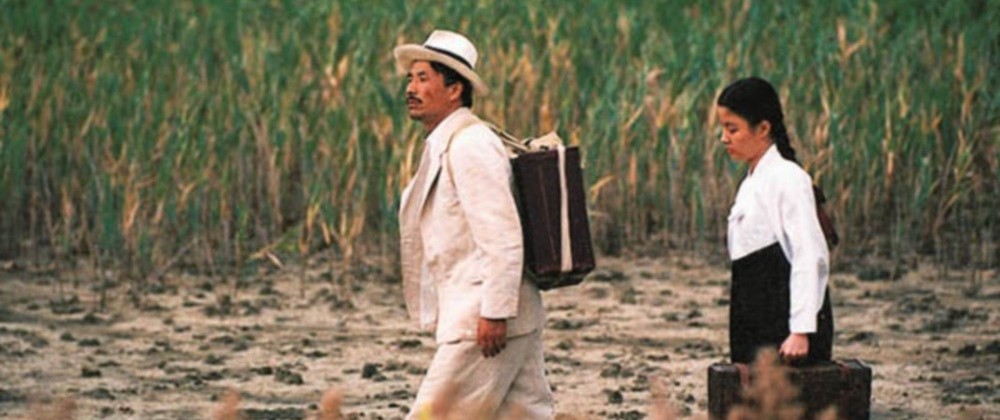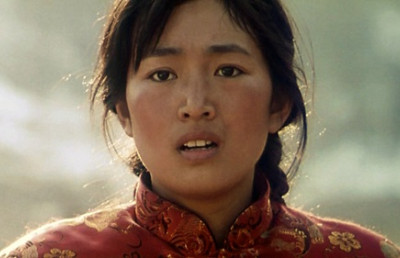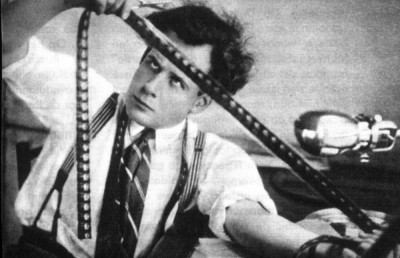Sopyanje
A stirring Korean style road movie

Sopyanje is a stirring Korean style road movie that weaves emotive Korean folk music (Pansori) and pastoral landscapes with a powerful plea for Korean identity. The film takes place in a post-world war 2 setting that saw Korea move from 35 years of Japanese colonialism to a nation divided by the allied powers of Russia and the United States. Director Im Kwon Taek displaces the contemporary setting somewhat by concentrating on a centuries-old form of singing and music (reciting is the more appropriate term), Pansori, that is best defined as a mix of opera, folk, and storytelling. Strikingly, Pansori has much in common with American rural blues, with its plaintive refrains and chilling voice vibrato, and philosophical belief that one can only express the necessary emotive power of a great Pansori singer by living and enduring grief and sorrow.
The film begins sometime in the 1960’s, with a young man, Dong-ho, getting off a bus and entering an inn in search of a famous Pansori singer (an iconic opening that recalls dozens of American and Italian westerns). Four minutes into the film we are taken back some twenty years with a striking cut from a close-up of Dong-ho to a slow-motion close-up of a Dong-ho as young boy. The narrative then progresses forward from this point, with junctured ellipsis’ and the odd cutback to the present. Dong-ho and his sister Songwa are the adopted children of Pansori master Yubong, a man obsessed with the art of Pansori. So much so that he feeds his daughter a drug that makes her blind so that she can remain at his side and experience the grief and sorrow (the “han”) necessary to become a great Pansori singer. The early parts show Yubong teaching Songwa and Dong-ho the art of Pansori singing and drumming. In a dissolve reminiscent of an identical temporal transition in Mizoguchi’s Sansho the Bailiff (1954), Kwon-Taek takes us from the young Dong-ho walking with his sister to an adult Dong-ho walking with his now older sister. Kwon-Taek uses this type of graphic match cut across large temporal leaps as an important formal element of the narrative, as in the scene of the changing seasons described below. From this point on we follow the painful and sometimes joyful sojourn of this threesome as they travel from village to village, performing as opening acts for travelling medicine shows or playing at restaurants and home dinners. The performances, wonderful in themselves, are also used to counterpoint the changes in Korean culture and society brought on by decades of military occupation, and the subsequent struggles with Korean identity and nationhood. As Washington Post writer Peter Young noted in his review from November 19, 1993, “ Their travails are an allegory of the intrusion of foreign influences into Korean culture. Pansori is a centuries-old art that was performed in both rural villages and the royal palace until the Japanese occupation in 1910, and many of its librettos are based on the most well-known Korean folk tales.”
As in the great films of Mizoguchi, and in many contemporary Korean films (see interview with Lee Kwang-Mo on his Spring in My Home Town), nature plays an important emotional backdrop to the action. For example, the scene of Dong-ho’s leave taking is strikingly staged in a natural setting chosen to underscore the scene’s emotional weight. No longer able to tolerate his father’s tyrannical streak, Dong-ho decides to leave his father and sister. The scene is broken into three shots, the first and third frame Songwa standing next to a huge, darkened tree, and the middle shot sees Dong-ho in extreme long shot running away. There is no overwrought music to accentuate the emotional break-up of brother-sister. Instead the overwhelming presence of the near-silhouetted tree, with its mournful hanging branches, represents an image of stability and rootedness that stands as a counterpoint to the familial rupture.
In interview with director Lee Kwang-Mo he noted, “I think Korean people are very connected to nature. We stay close to nature all the time. That is our culture and our tradition” ( Offscreen and in Cinemaya #43, Spring 1999, p. 35). As noted, the decision to set Sopyanje during the tumultuous post-world war 2 period allows Kwon-Taek to deal with questions of tradition and culture. As such, Kwon-Taek uses the overwhelming presence of nature as a strategy to connect or re-connect his characters and the traditional Pansori to something that is intrinsically Korean (while also being, in a sense, universal in a broader philosophical sense). A scene three-quarters into the film best expresses this strategy. Yubong and his now blind daughter, joined to him from behind by an arm-to-arm rope, are seen walking across the rural Korean landscape. The landscape changes from shot to shot but is bridged by Yubong’s melancholic Pansori song about the inevitability of aging, The song in its entirety is relevant to the scene’s formal meaning and complexity:
“Flowers open everywhere. Spring has come. Though spring is near I feel lonely. I was young yesterday. But I’m old today. Youth has deserted me, leaving me behind. The spring will leave me also, so I won’t welcome it. Come! Spring come! But go back if you wish. After you the summer comes. The forests turn green and the flowers blossom. Following the summer, the fall comes with the scenic beauty. Though frosty and windy, yellow chrysanthemums hold steadfast. The maple trees turn red. After the fall, the winter comes. The trees lose their leaves. When the snow flies, the moon, the snow, the world turn white. They all become an old man’s friend. Spring comes back every year. But my youth has gone. And it never returns. Listen my friends. Though you live 100 years, you sleep, you become sick, and you worry. So you only live less than 40 years in fact. Do you realize that?”
The scene lasts a little over four minutes across eight shots, which maps out to a languid average of 32 seconds per shot (considerably longer than the film’s still slow overall average shot length of 20 seconds). Because the shots are linked by straight cuts and matched by the continuous left to right screen direction of the two characters, the formal drive suggests continuous real time. However, the changing of the seasons visible in the landscape reveals an actual compression of many months to four plus minutes. In fact by the end of the scene Yubong appears considerably older, which suggests that perhaps the time traversed is several years (what Gilles Deleuze would call in reference to the time-image, an incommensurable or non-rational temporal link). Through the interaction of the song’s meaning and the elliptical, linear editing style Kwon-Taek portrays not only the importance of nature to Korean identity, but the subjective nature of time and the co-existence of personal linear time within nature’s cyclical time.
I’ll conclude by extending my earlier allusion to Mizoguchi’s Sansho the Bailiff . (To note, Sopyanje also bears some similarity to another Asian film of the same year, Hou Hsiao-Hsien’s The Puppetmaster .) Both Sansho and Sopyanje rely partially on the quest narrative (which also links again to Deleuze, who saw the post-war time-image dominated by the trip/ballad form). In both films the search is triggered by familial rupture. In Sopyanje the separation is willful, while in Sansho a noble family is separated through death (father) and forced exile. In both cases a brother searches for a family member, a sister in Sopyanje and a sister and mother in Sansho . Also, in both films the person being sought becomes blind (mother in Sansho). While the familial separation remains literal in Sansho , in Sopyanje the separation can be seen as a metaphor for the North-South division of Korea. A final striking parallel is in the image of plaintive song used as a soulful attempt to make emotional contact between estranged family members across an unbridgeable spatial divide. In Sopyanje the sister Songwa stands at a precipice singing her heart out into the open gulf. In Sansho the mother, exiled on an island, stands at the ocean shore singing the lullaby she once sang to her children.
Sopyonje 1993, Republic of Korea (South) Director :Im Kwon-Taek Writing credits : Myung-gon Kim, based on novel by Chung-Joon Lee Producer: Tae-won Lee Original music : Soo-Chul Kim Cinematography : Il-sung Jung Editing : Sun-duk Park Cast : Kyu-chul Kim (Dong-ho), Myung-gon Kim (Yubong), Jung-hae Oh (Songhwa)














